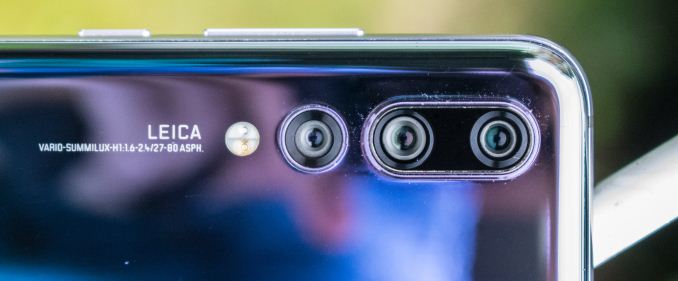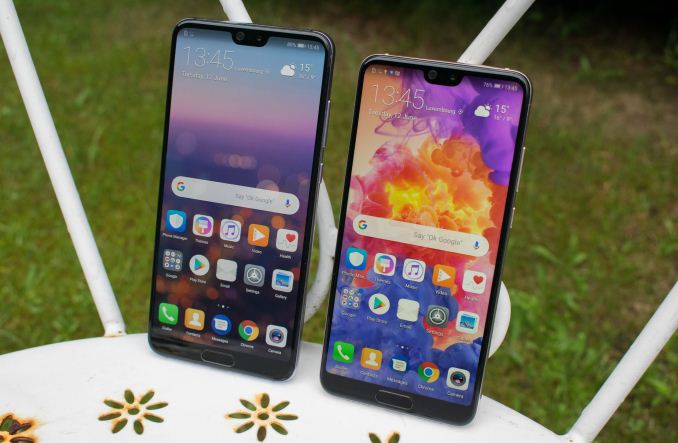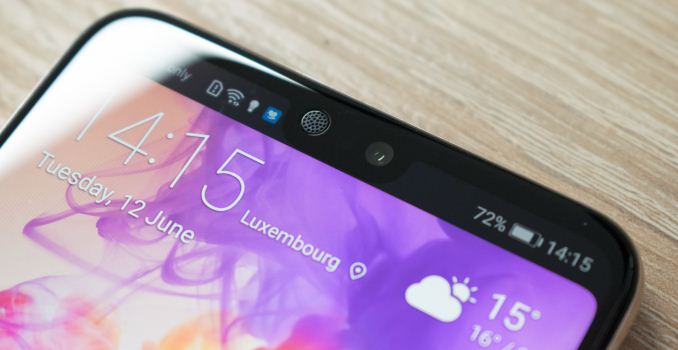The Huawei P20 & P20 Pro Review: Great Battery Life & Even Better Night Vision
by Andrei Frumusanu on June 15, 2018 11:00 AM ESTConclusion & End Remarks
The Huawei P20 and P20 Pro are hard to judge in terms of overall devices. Compared to last year’s P10 series, we see upgrades across the board in terms of design, performance, battery and camera. But what matters is the comparison to the competing devices as well, and there things are a little less evident.
Design-wise, the P20 and P20 Pro bring a large overhaul in Huawei’s design language and have very little in common with last year’s P10. Both phones have jumped on board the glass back design and it’s evident that Huawei tried to take some design cues from Apple’s iPhone X – with a similar camera layout and design as well as a trendy notch.
In my experience, the ergonomics of both new devices were very good and I think that’s also largely due to Huawei keeping the thickness to a minimal level. In terms of industrial design the only gripe I had with the phones were the glossy side-bezels that just didn’t really feel very premium – an issue that seems to be limited to the colour variation of the units I have as the black variant seems to opt for a matte finish instead.
As I did praise Samsung in the Galaxy S9 review for keeping it, I have to call out Huawei on removing the headphone jack on the P20’s. While this may be a little late now and I doubt we’ll see a return in the future (one can hope), it seems that I have to purposefully mention this in reviews so that other manufacturers avoid doing the same move in the future.
The screens of the P20 and P20 Pro are definitely experience defining as Huawei did a good job in designing a device with a notch without any of the negative side-effects. Applications work seamlessly with the notch and it never comes in the way in landscape views. In portrait mode, the notch is easily hidden by blacking it out and effectively it serves its original purpose: increasing the usable screen estate of the phones.
The P20’s LCD screen was the least impressive feature as I did not see any of the power efficiency advantages of the new RGBW layout while it provided an effective resolution and sharpness reduction compared to traditional RGB LCDs. The lacking default calibration settings also a negative point- however at least that can be remedied through individual adjustments by the user.
The P20 Pro screen fared a lot better, providing extremely accurate experience in sRGB mode, although DCI-P3 mode veered off too much in its blue saturations. Power efficiency was also in the norm – so the only negative here is I think Huawei could have gone with a 1440p display finally, given the increased size of the phone as well as the fact that it’s an AMOLED panel with less resolution power penalties.
Performance of the P20’s is very good and in everyday usage I found no issues with the phones. It’s to be noted that Snapdragon 845 devices offer a faster experience in everyday usage, so in that regard using last year’s CPU cores doesn’t fell that well for the Kirin 970. The biggest disadvantage is in the GPU performance where the P20 are just absolutely lacklustre due to the fact that the chipset uses a smaller configuration Mali GPU, and what seems to be that Huawei is running the P20 firmware and the SoC’s memory controller at a reduced speed.
What is lacking in performance is however more than made up in battery life. The P20 Pro is the longest lasting flagship device we ever tested and is a showcase of what happens when you combine a larger battery with an efficient screen and efficient SoC. The smaller P20, while not posting quite the impressive battery figures of the P20 Pro, still enjoys excellent battery life and outperforms the competition within its class.
The camera is by far the P20 Pro’s signature feature, so it may come as a surprise that I have my reservations about it. Huawei’s main issues here is that the camera experience in terms of shooting modes and getting the best result out of a given scene is very convoluted. The 40MP shooting mode is a separate resolution mode in the settings that has to be toggled on that disables the secondary zoom camera – something which generally doesn’t make sense to me. This, along with the fact that the 10MP mode is the default one enabled with the camera, makes me question just how usable the 40MP mode is in every day scenarios.
When comparing the 40MP captures – the P20 Pro does have notable advantage in terms of details. In 10MP mode, I would give it to competing devices such as the Galaxy S9 which is still king in terms of detail. Exposure in difficult situations also wasn’t quite up to par with Apple and Samsung so there’s definitely improvements to be one on Huawei’s camera calibration. The AI feature on the P20’s were also more detrimental than beneficial in terms of resulting photo quality – I think the camera could have largely done without it – luckily one can disable it.
The telephoto lens on the P20 Pro is what actually impressed me the most – its quality was generally superb and for the zoom factor that it gives it’s just a tier above all other optic 2x solutions currently found in other devices. What I think is the defining difference between the telephoto camera and the main camera is the fact that it’s the only one which actually includes OIS. The lack of OIS in general is I think what keeps the P20 Pro and P20 from really shining in terms of daylight picture quality – as overall now given both factors of exposure and detail retention, I prefer the Galaxy S9 or the V30. Video capture also suffers very badly from the lack of OIS, as Huawei’s EIS only works in 1080p30 mode and just doesn’t offer the same sharpness that a real OIS camera does.

In night time shots, the P20 Pro is a lot less controversial. First of all, the 40MP mode can just be ignored in low-light scenarios as it just doesn’t cut it. The pixel binning of four physical pixels into one logical pixels when using the 10MP is however what gives the P20 Pro an outstanding low light capture advantage. Again, in some scenes it maybe doesn’t quite match the S9’s detail retention, however it makes up for it with a very large dynamic range advantage that just creates much better low-light shots.
This is also the first phone camera that deserves to be in a category of its own: extreme low-light photography. Here the P20 Pro shines with its camera sensor that’s able to go to extremely high ISO values – but the P20 as well is able to provide some very impressive shots thanks to the Night mode which is essentially a new paradigm when it comes to computational photography.
So is the P20 Pro or P20 worth consideration? In Germany the P20 Pro and P20 can be found respectively at 730€ and 520€ while in the UK it’s still listed at near the launch prices of of £700-830 and £549. The direct competition here is obviously the S9+ and S9 – but there’s also now options such as the LG G7. I do think Huawei is recently pricings its flagships a tad too high, because they do have shortcomings that you would not want a device of that price-range to have.
Overall I think it’s going to be a very subjective decision based on what the buyer wants to prioritise, especially when it comes to battery life and camera experience. If you value battery life over everything else, then the P20’s are your go-to choice in terms of current flagships. If you value more performance and in particular gaming, you might be better served by a Snapdragon 845 device such as the G7, or have a look at last year’s G6 or V30. To be honest, this is a hard conclusion for me to write because the P20’s are such polarising devices having both some extremely good positives but also some few negatives. Best is, you go through the results yourself and build your own opinion!












81 Comments
View All Comments
Andrei Frumusanu - Sunday, June 17, 2018 - link
I meant to say that I emphasised it in the S9 piece by bringing it up, praising Samsung for keeping it. I'll reword it here.djayjp - Saturday, June 16, 2018 - link
I personally found the noise vs noise reduction smear balance of the s9 much more appealing in the night shotss.yu - Tuesday, June 19, 2018 - link
Me too. Huawei NR smears the most out of all the flagships (HTC's seems to smear the least, surprisingly) and the only thing in auto propping up that low light performance is that second 20MP monochrome, because the 1/1.7" 40MP main on its own is horrible, its low light performance alone is completely out of proportion with its sensor size (easily hands the win to S9 and Pixel2), even if you manually bin the 40MP's output down to 10MP its low light performance is good as useless, Phonearena already did such a comparison size-matching the output of the P20Pro 40MP and a regular Pixel2XL low light shot.djayjp - Tuesday, June 19, 2018 - link
Agreed! I think the author is out to lunch on this claim of his about the Huawei's supposed dominance in night shots. It clearly looks worse.nrecob - Saturday, June 16, 2018 - link
New Cameraphone: Huawei P20 Pro. Old phone" iPhone X.Enjoying my P20 Pro immensely! My regrets: not buying the "Twilight" version & buying an iPhone X in the first place.
banvetor - Sunday, June 17, 2018 - link
Why no comments or comparisons to the Google Pixel 2 in the camera pages? For me they still look the best in many cases (no pro photographer here though)Andrei Frumusanu - Sunday, June 17, 2018 - link
I didn't want to comment on every single phone and kept the phones to a minimum - personally I did not like the Pixel 2's shots - too much tendency towards unnatural HDR processing in daylight and too much noise and fuzziness in the night shots. Colour accuracy is the Pixel's forte I must admit though.banvetor - Sunday, June 17, 2018 - link
They look good to me exactly because of their HDR! And their colour of course. Anyway, appreciate the reply! CheersQuantumz0d - Sunday, June 17, 2018 - link
No excuse for Huawei on their glaring 3 major flaws.1- Design copy of EMUI as iOS
2 - Extended too deep as they just want to make the phone damn like an iPhone X with this Notch, camera module, the phone aesthetics, the plasticky frame look of that metal with polish like Apple again.
3 - No Headphone jack, another inspiration from Apple.
They want to be in serious front lines and all about their own AI powered notification system was a damn mess, I don't think it's going to be fixed anytime, Their lack of updates and price it to the north with tons of SKUs. After seeing the GSMA samples of Lumia 1020 Pureview, No camera comes close to that phone, they had Xenon flash, bigger massive sensor true lossless zoom and perfect natural colors unlike Huawei's AI crap or Samsung's oversaturated processing.
Their recent fiasco of no bootloader unlock is another middle finger. Removing the jack driling holes like Apple. sheesh this phone doesn't even deserve any praise on the design front, and should be called out for it's cheap design, Only Huawei phone which is a true flagship was Mate 10 standard edition, no rounded drama, no notch, has a headphone jack, front scanner, 16:9 panel, SD slot. This phone doesn't have any of those or any phone from Huawei.
Chinese phones nowadays have flooded the market with this obnoxious chin + notch BS and all phones are looking the damn same. A shame to the whole industry which Apple brought with their always fancy style over substance.
No wonder no ones cares about audio anymore, soon LG will stop bleeding and ditch that ESS (half baked anyways needs mods to enable the HIM - High Impedance Mode as they crippled it unlike the older days SGS - Wolfson Linux driver compatible DACs) as they did with V20's removable battery and made an abomination G7 ruining the perfect balanced design, 19:9 is so impractical and useless, adding the chin (yeah I've said it by 3 times) it's just insane and stupid.
Andrei shouldn't excuse them for adding a battery, Samsung's Note 8 has more tech inside it (ofc they played a stupid safe game of absurdly small battery) the stylus tech, Iris scanner, better construction and quality yet has a 3.5mm jack, S9+ improves on it, Note 9 rumored to have 3800+ mah (maybe it will help that failed Exynos 9810's custom kernel optimization) and have a 3.5mm jack again with SD Slot and all bells and whistles.
Upcoming Pixel 3 XL having a notch, just ruins the Android now. Every OEM on the planet want to be like Apple. Sigh, Sorry for the long rant.
GREAT Expectations - Monday, June 18, 2018 - link
Wow... It's just a phone. You sure do have strong opinions about this. Maybe use more full stops next time? Also IMHO, go get a life :)